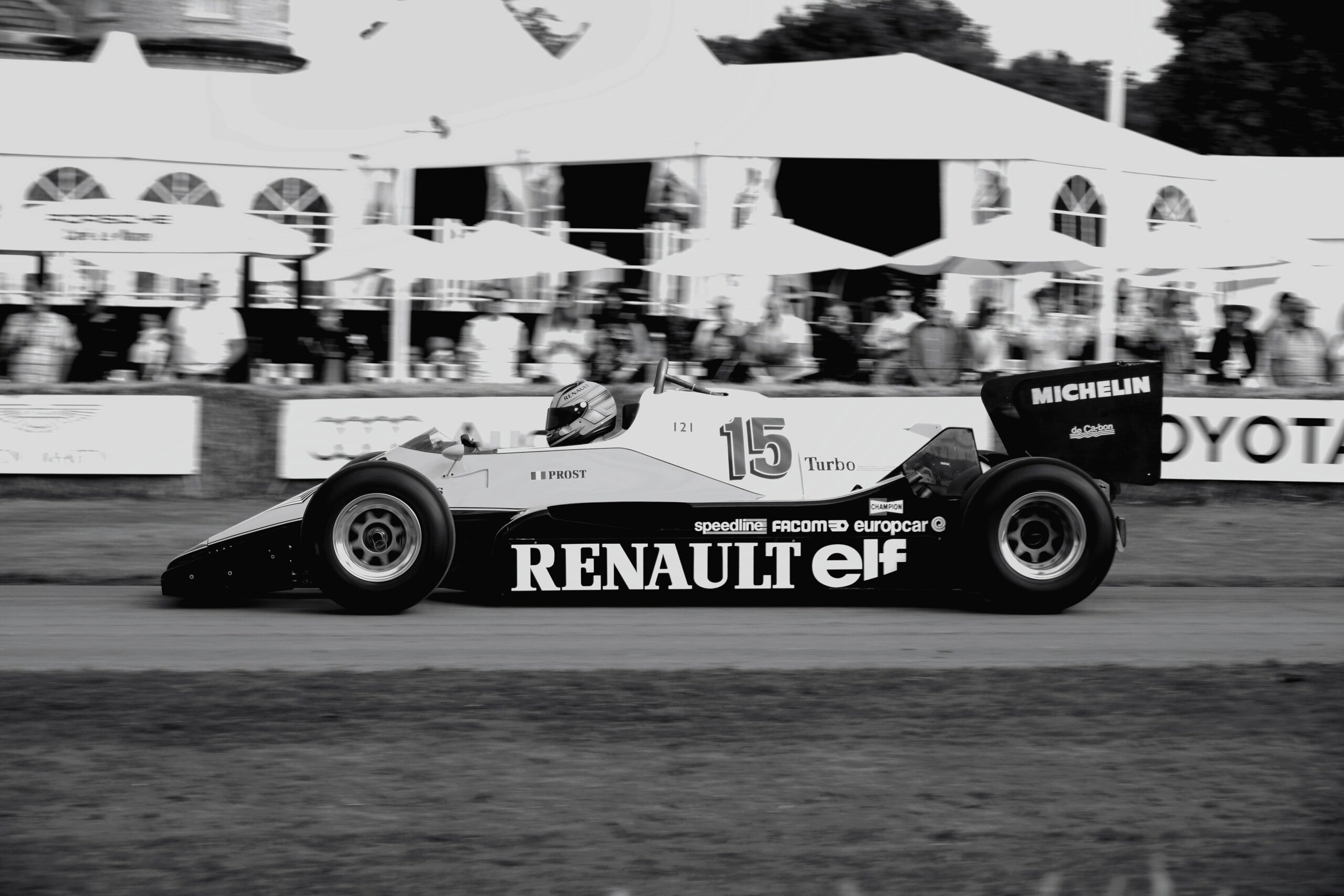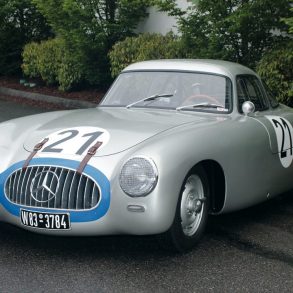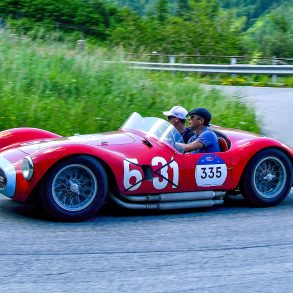Motor Racing History – Radical Technical Innovations & The Era of Ground-Effects
The Birth of Ground-Effects
Two major developments occurred during 1977, the Renault turbo made its debut at the British Grand Prix while the Lotus-Ford 78 debuted in Argentina. Both would effect racing for years to come. The Lotus was the first successful implementation of “ground effects” – the ability to harness the air that travels under the car. The idea had its origins in Land Speed Record cars back in the 30’s, specifically the Auto Unions designed by Professor Eberan-Eberhorst which employed side skirts as well as a shaped bottom supplying a venturi effect. In 1969 BRM experimented with various ground effect principles. Later at Lotus Tony Rudd and Peter Write, who had worked together at BRM further developed the concept along with Ralph Bellamy and of course Colin Chapman.
Chapman took special pleasure in the multiple use of components and the idea of using the air under the car found a willing champion. The missing element in earlier models was the adoption of flexible side-skirts. But even with skirts the amount of negative pressure was still quite small. Further tests were done on a wind tunnel with a rolling road. Chapman surmised that reducing the ground clearance would increase the pressure and further testing proved him right. Moving the nose airfoil closer to the rode surface so that the gap was only four inches caused the “road” surface to actually lift! The team would report their findings to Chapman each week and would be directed to pursue different ideas.
The first test of the car took place in August 1976, when Gunnar Nilsson secretly ran the car at the Snetterton circuit. The car was not raced that year so as to be able to spring it on the opposition the following year. Sprung it was at the Argentine Grand Prix but so new was the concept that few understood what it was that they were seeing.

The Belgian Grand Prix was held at Zolder this year but the conditions were the same, it rained. The first lap saw both front row cars, Andretti’s Lotus and the Brabham of John Watson eliminated in a collision. Conditions did not improve much for the remainder of the race but Andretti’s teammate Gunnar Nilsson won a popular victory coming from 3rd on the grid. At Monaco, Cosworth celebrated its 10-year anniversary when Scheckter scored the engine manufacturer’s 100 World Championship win. Monaco also saw the debut of a young Italian driver by the name of Riccardo Patrese. Andretti left his rivals behind at the Swedish Grand Prix at Anderstop only to run out of gas two laps from the end giving the victory to Jacques Laffite in his Matra powered Ligier. Andretti turned the tables on his rivals when he stole a victory at the French Grand Prix when Watson’s Brabham ran out of fuel.

The British Grand Prix also marked the debut of a young French-Canadian named Gilles Villeneuve driving a McLaren M23. With all of this the race was won by James Hunt. The German Grand Prix was moved to Hockenheim and won by Niki Lauda. Alan Jones driving a Shadow was the surprise winner of the Austrian Grand Prix while Niki Lauda continued to accumulate points with a second place. Lauda added a victory at the next race in Holland to give him a commanding lead while Andretti who had won three races was continually plagued by engine problems. Lauda also confirmed that he would be leaving Ferrari at the end of the year. Andretti won the next race in Italy but with Lauda’s second place the championship was almost his.
The clincher came at the United States Grand Prix won by James Hunt. Lauda refused to drive the two remaining races and Ferrari hired Gilles Villeneuve to finish the season. After victories by Hunt and Scheckter the season was finally over. It also marked the end of the line for BRM. The team from Bourne who last tasted victory in 1972 would be no more.
Mario Andretti had won 4 races in 1977 but reliability problems doomed his championship chances but in 1978 he would complete his boyhood dream and win the World Championship. For 1978 Andretti was joined by Ronnie Peterson at Lotus replacing Gunnar Nilsson who was suffering from cancer that would soon take his life.
Peterson joined Lotus in a supporting role hoping to restore his career after a disastrous time with Tyrrell. For 1978 Lotus was now using the new 79 with modified side pods that could be changed according to track conditions. In all Lotus won eight of the sixteen races that year with six going to Andretti and two going to Peterson.
New for 1978 was the Arrows team set up by Alan Rees, Jackie Oliver and ex-Shadow designer Tony Southgate. Their car was also a wing-car design though with some differences in side pod design. Ferrari with their new Michelin tires also scored several victories but the most striking car of 1978 must surly have been the Brabham-Alfa BT46 with its rear mounted fan for sucking air from the bottom of the car.
The car caused a sensation at the Swedish Grand Prix where it scored a convincing victory. The celebrations in the Brabham team were short lived as the car was banned shortly there after. 1978 marked the second time an American would become World Champion but Andretti’s title was forever marred by the death of his teammate, Ronnie Peterson at Monza.
In a decision that he would soon regret Carlos Reutemann left Ferrari for Lotus. He was replaced at Ferrari by Jody Scheckter who would be teamed with the hard charging Villeneuve. John Watson left Brabham for McLaren and his seat was taken in turn by the talented Brazilian Nelson Piquet. There was still a tire war going on between Michelin and Goodyear. Since Michelin only had to supply Renault as well as Ferrari their task was infinitely easier than Goodyear’s. More and more teams were incorporating some type of wing-car design and with the softer tires, the better cars were now able to achieve cornering forces of over 3g as compared to 1g in the early sixties and .6 to .7g during the last front-engined decade of the fifties.
Lotus came out with the Type 80 but the car was a disaster, forcing them to revert to last years Type 79. As had been their recent record this would be a down year for Lotus and the beginning of a general downward trend for the famous British team. The new Williams FW07 driven by Alan Jones and Clay Regazzoni would prove the rightful heir to the Lotus 79. Ligier resorted to a Ford-Cosworth DFV engine instead of using Matra V12s. Their car would prove especially adept on twisty sections. Brabham’s BT48 would prove fast in the hands of Lauda and Piquet but mechanical problems would plague the team for the entire year save for Lauda’s victory in the non-championship Dino Ferrari GP at Imola. Later that year Brabham would resort to an eight-cylinder Ford-Cosworth DFV in their BT49.
According to legend The Tyrrell 009 was built around plans for a model Lotus 79 that the company had obtained from model manufacturer Tamaya! Renault began the season with last year’s RS01 but with their ever more powerful turbocharged engine they were able to claim the first pole position of the season. By Monaco they converted to twin turbochargers in order to combat “turbo lag” and at the French Grand Prix they finally scored their initial victory.
The first two races of the season, Argentina and Brazil were won by Jacques Laffite for Ligier. Ferrari took the next race in South Africa while Ligier bounced back in Spain, this time in the hands of Patrick Depailler. The Belgian Grand Prix was very competitive with the lead changing six times before Jody Scheckter in a Ferrari put his car ahead for keeps. Monaco was a battle between Scheckter and the Williams of Regazzoni but try as he might the Swiss driver could not pass the red car.
Sadly this was the last Grand Prix for ex-World Champion James Hunt for after the race he quit the Wolf team and retired from racing. As noted earlier the French Grand Prix was won by Renault but it was the battle for second place between Villeneuve and Arnoux that captivated the fans. This late race duel with multiple passes, some in mid-corner added to the growing legend of the young French-Canadian driver. The fact that it had been for second place made it all the more remarkable.
The fast track at Silverstone was next and the Williams would dominate the Grand Prix as they and Ferrari would battle the remainder of the season for the title. In the end it was Ferrari’s reliability that would prove tough to beat as Scheckter would claim the title from his teammate Villeneuve with Alan Jones third.
The new decade saw a number of changes on the grid with the demise of Shadow, the merging of Wolf and Copersucar, and the comeback of Alfa-Romeo. Off the track there continued to be struggles between FISA and the Formula One Constructors’ Association (FOCA). The major manufacturer’s such as Renault, Ferrari (Fiat) and Alfa-Romeo tended to side with FISA while the British teams threw their lot with FOCA. This struggle also concerned turbo-charged engines championed by the former and sliding skirts and ground effects championed by the latter.
The year saw victories by four different drivers in the first four races including Alan Jones for Williams, Rene Arnoux for Renault, Nelson Piquet for Brabham and Carlos Reutemann in a Williams before Jones won again in Spain. Spain also saw a standoff between FISA and FOCA that resulted in the withdrawal of Renault, Ferrari and Alfa-Romeo along with any championship points being awarded the victor. With the series in disarray it was left to Goodyear to force the combatants to the negotiating table. The French Grand Prix looked set for a French victory with Arnoux leading Jacques Laffite only to be caught by Jones. Jones won again in England while Laffite finished first in Germany.
After a victory by Jean-Pierre Jabouille in Austria the next two races were won by Piquet. at Zandvoort. The title chase was now between two drivers, Australia’s Alan Jones and the Brazilian Nelson Piquet. With Jones taking the title with a victory at Watkins Glen.












